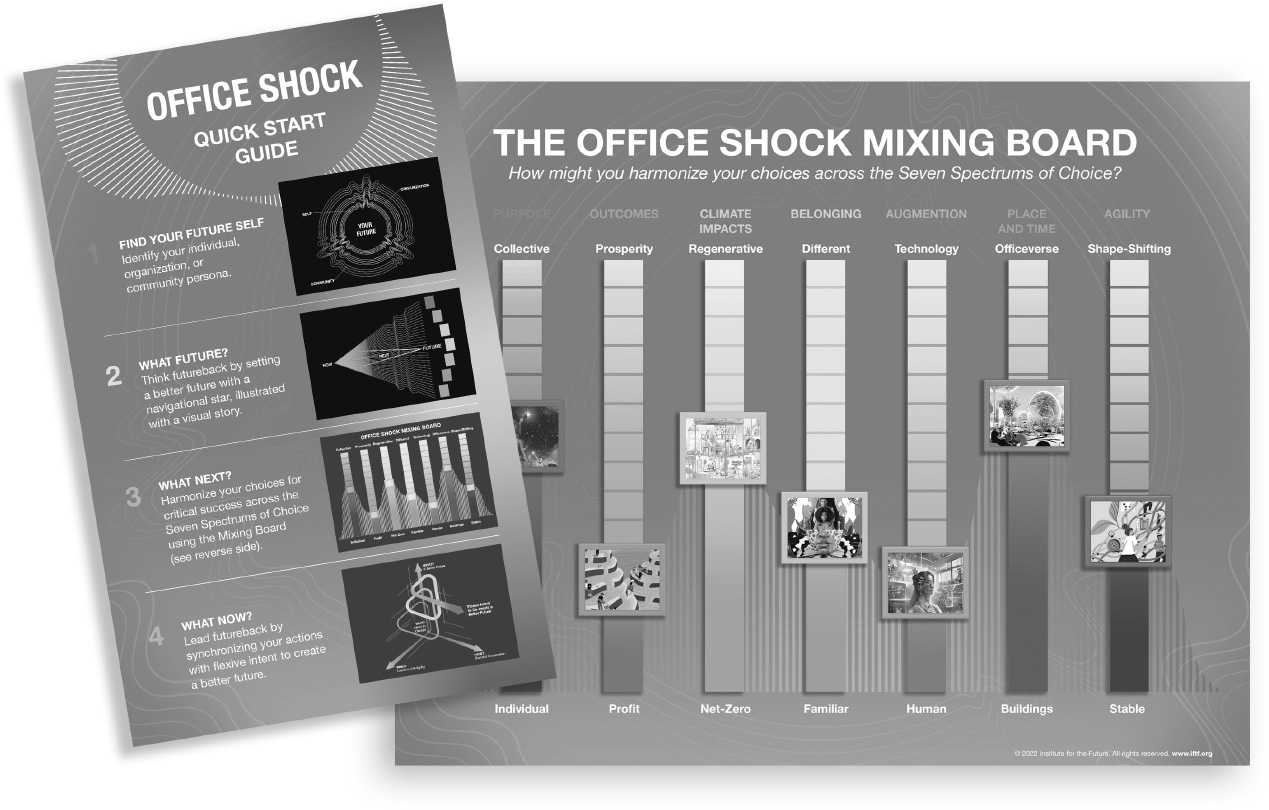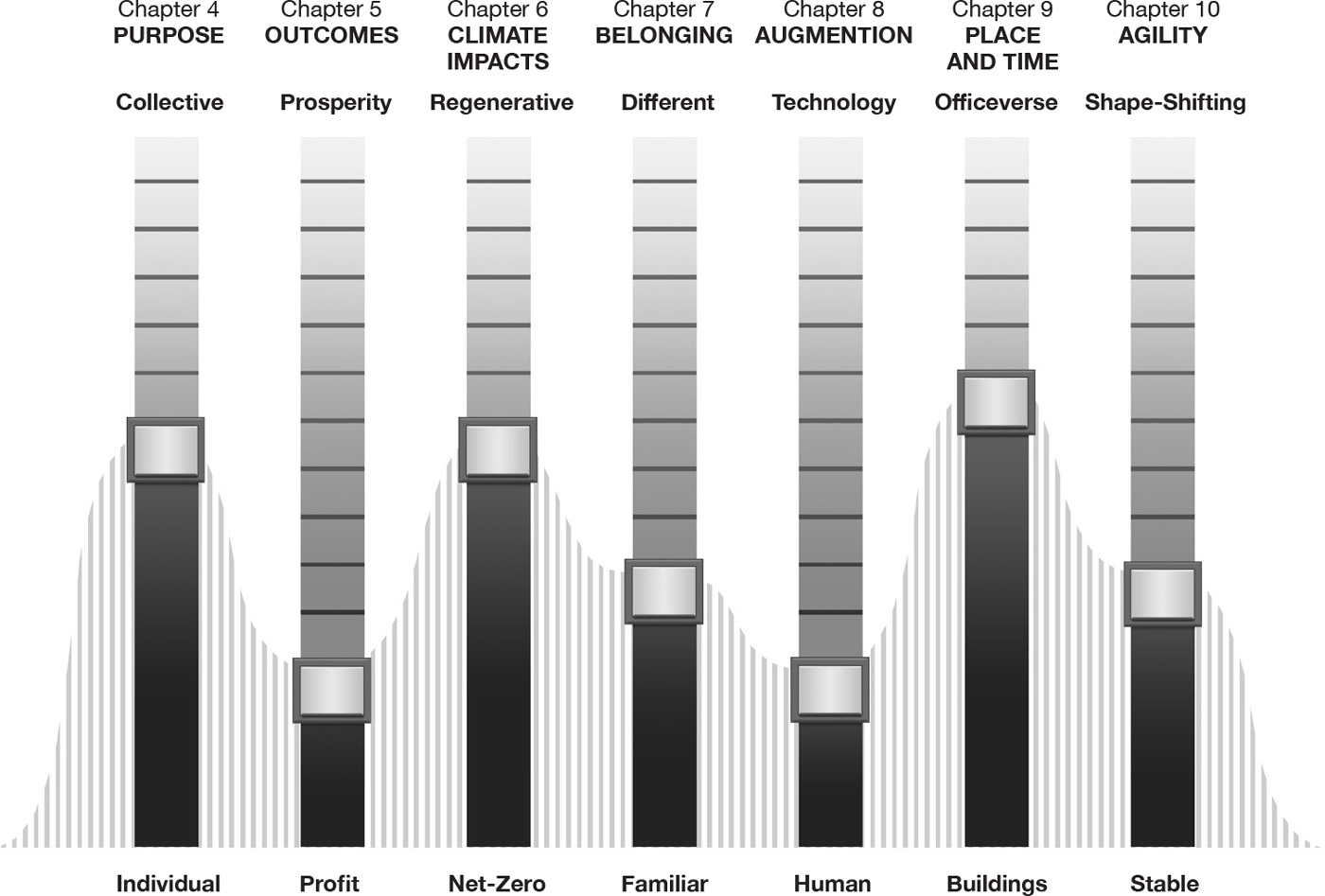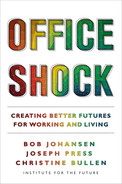ELEVEN
Thinking Futureback about Office Shock
Introducing Our Quick Start Guide
Imagine a world
in which a mixing board will help you think full spectrum to lead futureback. With this mixing board, you will be able to clarify your future of offices and officing while avoiding the traps of certainty. It will help you to make smart choices to harmonize within the Seven Spectrums of Choice (as introduced in part II of this book). The mixing board will help you synchronize your choices with others across the seven spectrums and reveal how your personal, organizational, and community choices can be coordinated for better working and living. It will help you avoid the dissonances, as you lead the transition with flexive intent.

FIGURE 19: Office Shock Quick Start Guide (see book insert after page 60)
The best office shock stories still need to be written.
In part I (What Future?), we introduced the futureback method and the full-spectrum mindset. We applied these to create possible stories from the impossible shocks we face in the VUCA world.
In part II (What Next?), we introduced the Seven Spectrums of Choice for offices and officing. The spectrums provide insight on the choices you will want to make for stories of futures with:
![]() Purpose (spanning individual and collective)
Purpose (spanning individual and collective)
![]() Outcome (spanning profit and prosperity)
Outcome (spanning profit and prosperity)
![]() Climate Impacts (spanning net-zero and regenerative)
Climate Impacts (spanning net-zero and regenerative)
![]() Belonging (spanning familiar and different)
Belonging (spanning familiar and different)
![]() Augmentation (spanning human and technology)
Augmentation (spanning human and technology)
![]() Place and Time (spanning buildings and officeverse)
Place and Time (spanning buildings and officeverse)
![]() Agility (spanning stable and shape-shifting)
Agility (spanning stable and shape-shifting)
In part III (What Now?), we invite you to write your own story for offices and officing.
To help you to think futureback about offices and officing, we’ve created a Quick Start Guide (figure 19) that brings together the spectrums’ mixing board and the other tools in this book.
The Quick Start Guide will help you win in the world of office shock. It can prepare you for whatever future comes—and more importantly help you make the future you want.
The Quick Start Guide presents an approach to developing your own clarity about offices and officing. It begins with defining who you are, then what future you want. Next is to make choices across the seven spectrums that inform what actions you want to take now to prepare yourself, your organization, and your community.
The Quick Start Guide will help you turn office shock into a great opportunity to create a better future.
Step 1: Find Your Future Self
Start by tearing out the Quick Start Guide in this book or retrieving it from the Office Shock web site.
Prepare for navigating office shock, by imagining
![]() Your Future Self as a worker (more to come in chapter 12)
Your Future Self as a worker (more to come in chapter 12)
![]() Your Future Self as part of an organization (more to come in chapter 13)
Your Future Self as part of an organization (more to come in chapter 13)
![]() Your Future Self as part of a community (more to come in chapter 14)
Your Future Self as part of a community (more to come in chapter 14)
Being aware of who you are in the future VUCA world isn’t easy. When COVID-19 hit, the boundaries between personal and professional personas were forcefully blurred. Now, after living with mandatory blurring, it is possible to make more conscious choices about how we want to work and live.
Thinking futureback about yourself is difficult for most people because our future selves are neurological strangers to us. Our brains, the prefrontal cortex in particular, shut down when thinking about ourselves in the future. For this reason, at IFTF we start our futureback workshops with an exercise we call “Find Future Self.” Once you find your Future Self, it will make the future feel more urgent to you. Awareness of your Future Self will prime your brain to be more open to ways the future will be different. It will motivate you to actively shape the future today for all the roles you play:1
![]() Your Future Self as an individual worker is the focus of chapter 12. To be ahead of the potential shocks of office shock, we recommend first choosing what is most important for you as an individual. What do you need for success in the future, and what are your choices?
Your Future Self as an individual worker is the focus of chapter 12. To be ahead of the potential shocks of office shock, we recommend first choosing what is most important for you as an individual. What do you need for success in the future, and what are your choices?
![]() Your Future Self as part of an organization is the focus of chapter 13. There you can reflect on what it means to be part of something bigger than yourself. Indeed, your choices about how to organize, both formally and informally, will be a primary influence on the future of the office.2
Your Future Self as part of an organization is the focus of chapter 13. There you can reflect on what it means to be part of something bigger than yourself. Indeed, your choices about how to organize, both formally and informally, will be a primary influence on the future of the office.2
![]() Your Future Self as a member of a community, and/or a policy maker, is the focus of chapter 14. Your role as a citizen in a community is the broadest future self. Here you can explore how to think futureback about what people and organizations choose to do together in the community. For example, successful delivery of public health requires individuals and organizations to work together for diagnosis, tracking, treatment, and prevention. If you are a policy maker, your choices may include zoning, public transportation, equitable access, availability of free networking, the rights of individuals, health benefits, and child-care options—just a few of the areas where policies can influence with whom we work.
Your Future Self as a member of a community, and/or a policy maker, is the focus of chapter 14. Your role as a citizen in a community is the broadest future self. Here you can explore how to think futureback about what people and organizations choose to do together in the community. For example, successful delivery of public health requires individuals and organizations to work together for diagnosis, tracking, treatment, and prevention. If you are a policy maker, your choices may include zoning, public transportation, equitable access, availability of free networking, the rights of individuals, health benefits, and child-care options—just a few of the areas where policies can influence with whom we work.
Office shock has created a need to harmonize the choices you will make in each spectrum. The mixing board opens an opportunity for a jazzlike conversation to help you synchronize between yourself and others on a better future for offices and officing.
Step 2: What Future?
With clarity about your future self, you can now think futureback about better futures for working and living. Begin by choosing a navigational star to guide your intentions.
Your navigational star is a direction of a better future that you will commit to pursue with flexive intent. If you need ideas about a compelling direction to pursue, then consider the UN Sustainable Development Goals as a North Star,3 or the variations we propose in the “Office Shock Navigational Stars” section at the end of this book. As discussed in chapter 3, the sanctioned yet broad nature of the Sustainable Development Goals make them good navigational stars4 to guide your flexive intent.
Your navigational star can also reflect a specific spectrum. For example, for pursuing Purpose you might say, “My future will focus on promoting well-being for people at all ages.” An example for Climate Impacts could be “In my future I will be a custodian of biodiversity.”
With increased clarity of What Future? you can then define What Next?
Step 3: What Next?
Flip the Quick Start Guide over to The Office Shock Mixing Board.
Our Office Shock Mixing Board has seven channels (what we call spectrums of choice) for you to move the sliders as you make choices (see figure 20). Each spectrum of office shock has polarities: extreme positions you can slide between. You can make different choices at different times in different situations.
Consider the breadth of the spectrum and where you want your balance to be. The polarities of each spectrum provide a wide range of options and your choice will likely reflect where you are in your career.
For example, if you are considering the Spectrum of Outcomes, as an individual, you may choose to position yourself toward the top, but not all the way, indicating that you are balancing your requirement for personal profit with a desire to contribute to improving the prosperity of others.
To make the spectrums more manageable, we encourage you to define your critical success factors5 that will show you the way toward your preferred future. This interview process was developed by Christine Bullen and Jack Rockart at MIT. It was one of the first initiatives to identify links between information technologies and corporate strategy. They will help crystalize your intentions, where you are on the span of the spectrum, and the path forward.

FIGURE 20: Office Shock Mixing Board: Harmonize the spectrums of choice for navigating office shock.
The critical success factor interview questions are designed to provoke you to think about what would need to go right for you to successfully turn office shock into a great opportunity. They ask you what failures, if they occurred, would hurt you the most? If you disappeared magically for three years and your life went on, what would you most like to know about your organization when you returned?
Answers to these questions will help you to define your critical success factors. Knowing your critical success factors will inform your choices for What Next? It will also reveal any gaps and any requirements you will need to synchronize with others.
For example, for the Spectrum of Outcomes, you might say, “In my future I want to find inclusive, productive, and decent work for both me and my workforce community.” An example for the Spectrum of Augmentation might be, “I want to learn the best way to augment my intelligence as quickly as possible.”
To help you define what’s next, chapters 12, 13, and 14 contain a list of possible critical success factors to provoke your choice-making for each spectrum.
These are not binary either/or choices. There is a full spectrum of possibilities between the polarities. The mixing board provides a way to help you see and think through your choices—and the implications of your choices for others.
Step 4: What Now?
Turn your choices into actions by defining what, how, and who to guide your journey. We recommend using a scaffolding as shown in figure 21 to ensure clarity of your intent and provide the space to be flexible about how you pursue it.
In IDeaLs (Innovation and Design as Leadership): Transformation in the Digital Era, Joseph and his coauthors researched how companies engage people for transformation. Flexive intent best describes the type of collective leadership demonstrated by Philips and seven other companies on their transformation journey.
For example, Philips’s evolution from a consumer product company to a technology health-care company began in 2011.6 The signposts along Philips’s journey to lead the industry toward value-based care are indicative of innovation, design, and leadership. Funding for pre-seed accelerator projects was fast-tracked, a design thinking methodology called “co-create” became the standard for collaborative activities, and leadership development was augmented with futureback thinking to accelerate the digital transformation.7
Models illustrating transformation are typically flat and linear, what anthropologist and author Josh Berson refers to as the “landscape metaphor.” To grasp how communities enact change over time, he recommends considering a scaffold that supports and bounds the collective search for action.8

FIGURE 21: The IDeaLs’ Transformation Scaffold (adapted for Office Shock). With flexive intent, change can be cultivated in complex environments.
Inspired by Bergson and indicated in the research with Philips and others, the IDeaLs team proposed a 3-dimensional scaffold for coordinating with clarity across three dimensions.
There are four important dimensions of this model:
1. Intent to Change (Why?): An intention to change an existing situation into a preferred one.
2. A Better Future for Offices (What?): The more meaningful experiences of people that provide opportunities for them to participate in the preferred future, often resulting from stated critical success factors.
3. Gameful Cooperation (How?): The means to engage people in the co-creation of the preferred future.
4. Leaders with Agility (Who?): The ways to engage people to develop a deep level of commitment that leads to actions that change existing situations into preferred ones.
Leaders will need both clarity and flexibility in creating more resilient and inclusive organizations, a key characteristic of an agile organization. IDeaLs is a scaffold for coordinating with clarity, and flexive intent is the means to climb the scaffold. This place of possibilities is where the American physicist and feminist theorist Karen Barad sees agency—a space of possibilities for change.9 The choices of how to coordinate change with clarity on the transformation journey will either make or break any intentions for better futures.
Clarity of direction is essential, and so are the contours that will influence your trajectory. Think of the spectrums as guardrails. Understanding the span between them helps guide your choices along the spectrum. You’ll want to know what spectrum you are on and what the extremes are so you can choose where you want to be.
Thinking full spectrum (beyond simplistic categories) will help you stay in sync with others on the road toward better futures for working and living. As illustrated in figure 22, synchronizing your choices on the Seven Spectrums of Choice will vary as you consider your own needs, the needs of your organization, and the needs of your community.
Synchronizing Your Future Selves
The conversation around the Seven Spectrums of Choice (both with yourself and others) should help you harmonize within and across each spectrum. It will also reveal a way to sync with others as they apply futureback thinking to make the best of office shock.
Your personal story has most likely evolved since its initial creation. In this chapter we have introduced the concept of the mixing board for helping to navigate the choices on the seven spectrums. Consider how thinking futureback with the Quick Start Guide can help to continue to evolve your story:
1. How has finding Future Self helped you to envision your future self and prepare you to take on a variety of roles in the VUCA world?
2. How have the UN Sustainable Development Goals helped you to define a navigational star to guide your futureback method and keep your full spectrum mindset?
3. How can the mixing board help you to consider your choices along the seven spectrums and synchronize with those of your organization?
4. How can the IDeaLs scaffold inform your transition story toward a better future?

FIGURE 22: Synchronizing Your Future Selves. A visual reminder to stay in sync with others on the office shock journey.
